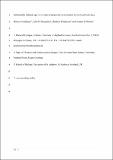Files in this item
Substantially inflated type I error rates if propensity score method is not fixed in advance
Item metadata
| dc.contributor.author | Neuhäuser, Markus | |
| dc.contributor.author | Kraechter, Julia M. | |
| dc.contributor.author | Thielmann, Matthias | |
| dc.contributor.author | Ruxton, Graeme D. | |
| dc.date.accessioned | 2021-05-18T23:47:51Z | |
| dc.date.available | 2021-05-18T23:47:51Z | |
| dc.date.issued | 2020-05-19 | |
| dc.identifier | 268295880 | |
| dc.identifier | 7dc5edba-e73e-4d79-a104-f3b4d92eff31 | |
| dc.identifier | 85085298873 | |
| dc.identifier.citation | Neuhäuser , M , Kraechter , J M , Thielmann , M & Ruxton , G D 2020 , ' Substantially inflated type I error rates if propensity score method is not fixed in advance ' , Communications in Statistics: Case Studies, Data Analysis and Applications . https://doi.org/10.1080/23737484.2020.1763219 | en |
| dc.identifier.issn | 2373-7484 | |
| dc.identifier.other | RIS: urn:49A91B09D3BD61909C83650100A8DED7 | |
| dc.identifier.other | ORCID: /0000-0001-8943-6609/work/75248634 | |
| dc.identifier.uri | https://hdl.handle.net/10023/23220 | |
| dc.description.abstract | Propensity scores are often used to adjust for between-group variation in covariates, when individuals cannot be randomized to groups. There is great flexibility in how these scores can be appropriately used. This flexibility might encourage p-value hacking – where several alternative uses of propensity scores are explored and the one yielding the lowest p-value is selectively reported. Such unreported multiple testing must inevitably inflate type I error rates – our focus is on exploring how strong this inflation effect might be. Across three different scenarios, we compared the performance of four different methods. Each taken individually gave type I error rates near the nominal (5%) value, but taking the minimum value of four tests led to actual error rates between 150% and 200% of the nominal value. Hence, we strongly recommend pre-selection of the details of the statistical treatment of propensity scores to avoid risk of very serious over-inflation of type I error rates. | |
| dc.format.extent | 7 | |
| dc.format.extent | 371202 | |
| dc.language.iso | eng | |
| dc.relation.ispartof | Communications in Statistics: Case Studies, Data Analysis and Applications | en |
| dc.subject | Propensity scores | en |
| dc.subject | Multiple testing | en |
| dc.subject | Observational study | en |
| dc.subject | QA Mathematics | en |
| dc.subject | T-NDAS | en |
| dc.subject.lcc | QA | en |
| dc.title | Substantially inflated type I error rates if propensity score method is not fixed in advance | en |
| dc.type | Journal article | en |
| dc.contributor.institution | University of St Andrews. School of Biology | en |
| dc.contributor.institution | University of St Andrews. Centre for Biological Diversity | en |
| dc.identifier.doi | 10.1080/23737484.2020.1763219 | |
| dc.description.status | Peer reviewed | en |
| dc.date.embargoedUntil | 2021-05-19 |
This item appears in the following Collection(s)
Items in the St Andrews Research Repository are protected by copyright, with all rights reserved, unless otherwise indicated.

